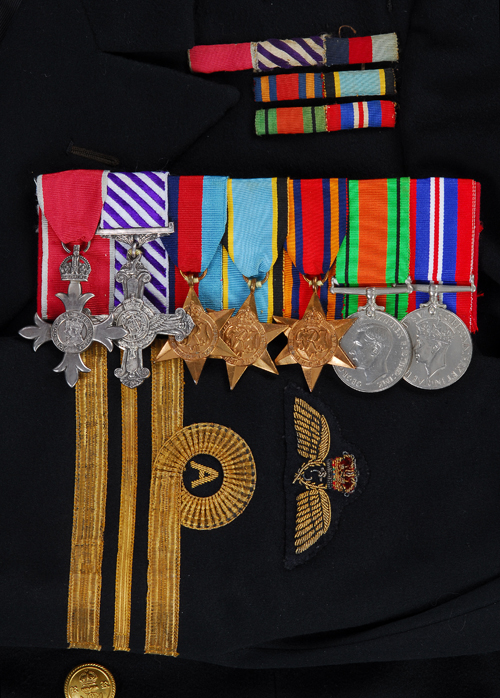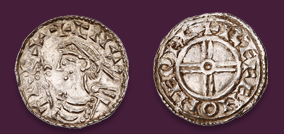
Auction: 7029 - Orders, Decorations, Medals & Militaria
Lot: 376
An Unusual Royal Navy Ferry Flight Pilot´s M.B.E., Second World War ´1942, Burma Operations´ D.F.C. Group of Seven to Buffalo, Hurricane, Typhoon and Meteor Pilot, Squadron Leader, Later Lieutenant Commander J. ´Pancho´ Brandt, Royal Air Force and Royal Naval Reserve Air Branch, Who Was Credited with Shooting Down at Least Two Japanese Aircraft, and Several Troop Trains both in Burma and France, He Was Shot Down South of Amiens, 23.5.1944, Where He Evaded Capture For Three Months and is Reputed to Have Taken Part in Resistance Operations Under His Assumed Identity as Roland Louis Vandal a) The Most Excellent Order of the British Empire, 2nd type, Civil Division, Member´s (M.B.E.) breast Badge, silver, with Royal Mint case of issue b) Distinguished Flying Cross, G.VI.R., reverse officially dated ´1942´ c) 1939-1945 Star d) Air Crew Europe Star e) Burma Star f) Defence and War Medals, generally very fine, mounted as originally worn, with the following related contemporary items: - Cigarette case, silver plate, by Shorts, 1950, lid engraved ´39849 S/Ldr. J. Brandt. D.F.C.´, front and back of case engraved with the insignia and mottos of the Squadrons that Brandt served in, ´26, 36, 42, 67, 137, 263´, inside of case engraved with recipient´s postings from May 1937-November 1950; Tinned Flying Rations Type B - Royal Air Force Officer´s Tunic, with D.F.C., 1939-1945 Star, Air Crew Europe Star, Burma Star, Defence and War medal ribands; Royal Naval Reserve Officer´s Tunic, with recipient´s full entitlement of ribands; Cap, with the initial ´B´ inside; spare piece of R.N.R. Bullion insignia; (3) associated neck ties with the following original documents: - (2) Royal Air Force Pilot´s Flying Log Books (May 1937 -19.12.1953), 1st lacking front and back covers, with water damage; (4) Royal Navy Pilot´s Flying Log Books (7.1.1954-16.1.1967) - Bestowal Document for the Most Excellent Order of the British Empire (M.B.E.), dated 1.1.1958, with the Statutes of the Order - Commission appointing J. Brandt as Acting Pilot Officer, Royal Air Force, dated 28.10.1937 - Commission appointing J. Brandt as Lieutenant-Commander (A), Royal Naval Reserve, dated 9.7.1956 - Letter from the Air Ministry to Mrs. J. Brandt, Rowena Court Hotel, Westgate-on-Sea, informing her that the recipient has been reported missing in action, dated 30.5.1944; a further letter from the same source to Mrs. Brandt informing her that her husband has been confirmed as alive, dated 27.7.1944; several photographs of the recipient; named and dated scroll certificate conferring the ´Order of the Cardinal Puph´ upon the recipient; (12) Pilot Flying Handbooks including on Spitfires, Wyverns, Avengers and the Dragonfly Helicopter, all of which Brandt flew during his career; a set of Royal Naval Reserve Regulations - Part copy of recipient´s unpublished memoirs and another set of unpublished memoirs called Bloody Shambles, which makes several references to Brandt; recipient´s passport; correspondence and other ephemera (lot) Estimate £ 2,800-3,200 M.B.E. London Gazette 1.1.1958 Lieutenant-Commander (A) Jack Brandt, D.F.C., R.N.R., Civilian Ferry Pilot, Royal Naval Ferry Flight, Short Brothers and Harland Ltd., Rochester, Kent. D.F.C. London Gazette 10.11.1942 (39849) Squadron Leader Jack Brandt, R.A.F.O., 67 Sqn. The Recommendation states: ´This Officer took over Command of 67 Squadron. The Squadron was equipped with Buffaloes and later rearmed with Hurricane II´s. S/Ldr. Brandt is a courageous and dashing leader. To his credit he has one enemy bomber and one enemy fighter destroyed and four damaged. Additionally, he destroyed and damaged a number of enemy aircraft on the ground in attacks on enemy air bases. His Squadron at all times showed a very high fighting morale. This spirit with which it invariably went into attack the enemy at close quarters was marked.´ Squadron Leader Jack ´Pancho´ Brandt, M.B.E., D.F.C., born Shanghai; commissioned Acting Pilot Officer Royal Air Force, May 1937; posted 36 Squadron, Seletar, Singapore (Wildebeeste, torpedo bombers), 1938; Flight Lieutenant 10.2.1941; posted Flight Commander 67 (Fighter) Squadron, Mingladon, Rangoon, Burma (Brewster Buffaloes), 9.10.1941; stayed in this posting with the outbreak of the Second World War and had to wait until war was declared on Japan, 8.12.1942, ´I could almost have blessed the Japs for their starting their nonsense in the Far East - At least I felt I was earning my pay!´ (letter from recipient included in lot refers); whilst based at Mingladon Brandt faced the constant attention of the Japanese Air Force, managing to be wounded and claim two enemy aircraft in the space of a few weeks, 25.12.1941, ´Mingladon attacked by 2 waves of 24 bombers 20 fighters each. 18 shot down - claimed 1 fighter 1 bomber´ (Log Book refers) and on a similar enemy raid, ´I started to run towards my aircraft when I was struck across the back by a piece of shrapnel.... A hangar was destroyed with quite a few buffaloes therein´ (typed career details included in the lot refers); 9.1.1942, ´Ground straffing of Tak Aerodrome - Thailand. 1 Bomber´ (Log Book refers); 12.1942 ´Ground straffing of Prachuab and Hua Hin Aerodromes - Damaged 2 A/C on ground - damaged one train near Bangkok´ (Log Book refers); 24.1.1942, ´Mingladon raided by 7 bombers, 24 fighters - All bombers, 11 fighters shot down - damaged 3, shot down 1 Bomber´ (Log Book refers). Pancho´s Circus Officer Commanding 67 Squadron, 28.1.1942 and converted with his Squadron to Hurricanes, the majority of the Squadron were made up of New Zealanders and had already gained a reputation under his leadership, ´A young New Zealander flying a Buffalo fighter yesterday wrecked a Japanese troop train in Siam, reports the Daily Express Rangoon Correspondent. The pilot leads a flight known as "Pancho´s Circus" because of his blue chin and good-looking Mexican type of face. He flew so low over the train that the plane passed through the smoke from the funnel. The train bristled with machine-guns, which blazed away, but the pilot put a couple of hundred bullets into the boiler and the engine blew up, wrecking the train. It was Pancho´s lucky day, because he also destroyed two Japanese planes on an airfield and shot up a railway station´ (newspaper cutting refers, for further details see Log Book entry above). Shot Down, and Evading Capture in Occupied France Posted 225 Group H.Q., Bangalore, 19.9.1942; posted 55 O.T.U., Annan, Scotland, 14.12.1943; Squadron Leader 1.1.1944; returned to operational flying with 137 Squadron, Lympne (Typhoons), 23.3.1944 and flew in operations with the Squadron including 23.5.1944, ´Long range sweep, destroyed 1 Engine 47 ammo coaches, Chaulne Somme, shot down in flames by light flak - evaded capture - contacted in Paris U.S.A. Forces, 27.8.1944´ (Log Book refers); Brandt goes on to talk about the incident in more depth, ´it was a classic piece of ground to air shooting, mostly in the engine and cockpit. I was too low to bale out, the engine was on fire so I did the next best thing - guessed where the ground was and pulled the stick back. I think I was doing about 300kts. Fortunately traversing several farms two roads and knocking down two posts.... The next thing I knew, my leg was burning and I was choking... I couldn´t see. I couldn´t breathe. I´d cut my head a bit and my helmet was filling with blood´ (recipient´s unpublished memoirs, One of the Few, refers); Brandt had crashed just south of Amiens, he managed to crawl 20 yards away from his wrecked plane and hide in a cornfield, ´The Germans had arrived in trucks... and when it was quite dark... they pushed off leaving two armed guards over the aircraft... I started scratching my brains about what to do. I was getting tired and hungry and my head was sore and ached like hell. My leg was giving me gyp and I discovered that I had also burnt my wrist.´ (Ibid) Despite it being pitch black and the guards only being 20 yards away, Brandt, after a fortifying cigarette, decided to make a dash for it, ´at 5am I had got a reasonable distance away, and as it now was light, I decided to hide up in a thick hedge for the day or until I saw a chance of something - any sort of chance.´ A French farmer came to his aide with some food, before he decided to push on again. That night, still hampered by his injuries, he crawled into a nearby wood, ´in that wood was a dug-out and I found it. It was a relic of the ´14 War. It was very deep and damp as a swamp and stank like a drain - but to me it was a palace. There was even a rotten old table and chair down there.´ (Ibid) After 5 days of recuperation, Brandt was discovered by a local boy, who through contact with another local put him in touch with ´Henri´, a resistance member, who was sure that he could smuggle him to Paris, ´Henri thought that the best way for me to do the trip was in a truck that made deliveries from the farm to the capital. He said he would let me know when it could be arranged..... I was five days in the dug-out before everything was fixed...... Henri brought my clothes the night before. They were a sports jacket, a shirt and some plus four looking pants. They took away my silver identity disc, my watch and my pencil because my name was on them. I put on the clothes and stuffed the uniforms into a hole... He produced my new identity card. It said my name was Roland Louis Vandal. I was a Frenchman from Lille, whose wife and family had been killed by the American bombing of that town. I was an electrician, explaining away the burn marks.´ Upon arrival in Paris Brandt was hid by the Couvert family (both members of the resistance) and it is reputed that he joined with the resistance and under his assumed identity took part in several operations against the German occupational army. When Paris was liberated in August 1944, Brandt went to the American forces only to be incarcerated before being properly identified. Jet Planes, and a New Start Having finally returned to the UK and after undertaking several administrative roles he was posted as Officer Commanding 263 Squadron, Acklington (Meteors, one of the 1st Jet Squadrons in the British Air Force) and moved with the squadron to Church Fenton, April 1946; posted Officer Commanding 26 Squadron, Fassberg, Germany (Tempests), May 1947, ´In 1950 I left the RAF and the very next day joined the Naval Ferry Flight of Short Bros. & Harland with which I had 16 years of sheer bliss flying any amount of different aircraft to any amount of different places.´ Having taken a commission (Lieutenant Commander) in the newly formed Air Branch of the Royal Naval Reserve, Brandt, based at Rochester, flew and delivered many different types of aircraft to and for the Fleet Air Arm, ´the task consists of providing pilots to fly aircraft on transfer from one Air Station to another, to and from contractors´ airfields, and operating taxi aircraft to position pilots as required. The aircraft handled, therefore, range from brand new shining monsters from factory airfields to oil streaked, battered "heaps", passed fit for "one ferry flight only" and going for scrap.... The Ferry Pilot´s life is a nomadic one, with several nights in different wardrooms and on trains each week. It is the proximity of the London rail centres that makes Rochester so suitable a base for the unit. Living out of a parachute bag is one of the drawbacks of the job. Flying a great variety of aircraft types is one of the attractions.´ (article included in lot refers). Brandt retired in 1967, after 30 years of service and having flown in approximately 61 different types of aircraft.
Sold for
£3,000




